It is an unlikely site for a revolution: more likely, you would think, to be noted for its collection of Cuban crocodiles than its cameo at the birth of a potentially world-changing industry.
But for the past three years, Paignton zoo in Devon has been growing food for its animals using a Verticrop greenhouse, one of the world’s first working examples of a vertical farm, a radical new approach to agriculture that many believe could address one of humanity’s most pressing problems: feeding our rapidly growing population.
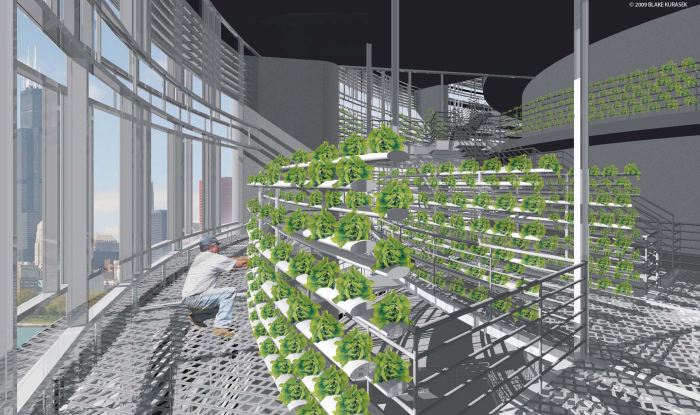
Currently around the seven billion mark, the world’s population is expected to rise to 10 billion by 2050. But with 80 per cent of the planet’s usable farmland already cultivated, the effects of climate change wreaking havoc across large areas of existing farmland, and more than 10 per cent of humanity going to bed hungry every night, growing enough food for these three billion new mouths is not going to be easy.
It’s a bleak picture. But there’s still time to do something about it. And, as with many of the world’s biggest problems, engineers can play a major role. Whether it’s through the development of precision farming methods that use satellites and sensors to optimise agricultural operations, the invention of technology that can help make plants more resistant to a hostile environment, or some more fundamental change in the way we grow, harvest and distribute our food.
Dr Dickson Despommier, a former professor of microbiology at Columbia University in the US, believes there is only one sustainable solution: sever our 12,000-year-old link with the soil, embrace technology, and move farming indoors and upwards.

Although he doesn’t claim credit for inventing the term, Despommier is widely regarded as the founding father of the vertical farming movement, and he puts forward a compelling case for the approach in his 2010 book The Vertical Farm. In it, he envisages the creation of urban structures that would enable urban farmers to cram valuable growing space into high-rise buildings, exploiting the space-saving benefits of growing upwards.
Using hydroponic and aeroponic systems rather than soil, and deploying the latest sensing technology to monitor and regulate growing conditions, these closed-loop facilities would grow crops all year round. Plants would be protected from pests and weather, all water would be recycled, and there would be no agricultural run-off, one of the most environmentally damaging forms of pollution.
It sounds far-fetched. But from the terraced rice paddies of south-east Asia, to the hillside farms of the ancient Mayans, the use of vertically layered growing techniques is hardly a revolutionary concept. The hanging gardens of Babylon — if it existed — is arguably another, even earlier, example of a vertical farm.
What’s changed, claims Despommier, is that we now have the technology to take the vertical farm to the next level. ‘I believe we’re on the cusp of a logarithmically increasing growth phase for indoor farming — so we can control everything indoors, we can make plants do what we would like them to do and we can produce so much more of the plants of our choice indoors than we can outdoors.’
And his isn’t a lone voice. Since the publication of The Vertical Farm, prototypes have begun springing up all over the place. Last year, the South Korean government unveiled one in Seoul, which is using LED lighting to grow leafy green vegetables on three storeys. A similar facility has been built in Kyoto, Japan, and prototypes are currently being constructed in Sweden, Holland and the US. And although the scale and volume of these facilities is currently fairly modest, the concept appears to be gaining credibility and momentum.
Indeed, just last month (November 2012) the firm behind the Paignton Zoo facility, Canadian company Alterrus Systems, announced the formal opening of its first fully commercial vertical farm.
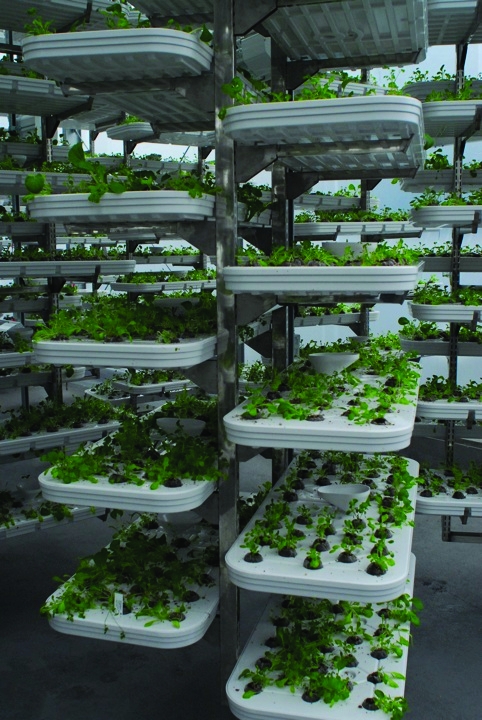
Based on the rooftop of a car park in downtown Vancouver, the farm is now supplying vegetables to a number of nearby restaurants through an online local grocery delivery service.
Christopher Ng, chief executive officer at Alterrus, told The Engineer that his group has consciously taken a step back from the huge facilities envisaged by Despommier, and developed an approach to vertical farming that can be integrated easily into existing urban spaces and has immediate commercial potential.
Originally devised in the UK, the company’s Verticrop system uses a low-power conveyor to move a series of stainless steel racks holding 24 vertically stacked (1 x 0.5m) hydroponic trays around a greenhouse at around 2.7m/min. The company’s latest facility consists of 120 individual racks, covers 4,000ft2 of growing space, and will produce 150,000lb (68 tonnes) of leafy green vegetables and herbs a year, Ng said. He also claimed that the greenhouse uses just 10 per cent of the water required in traditional field agriculture while producing considerably higher yields.
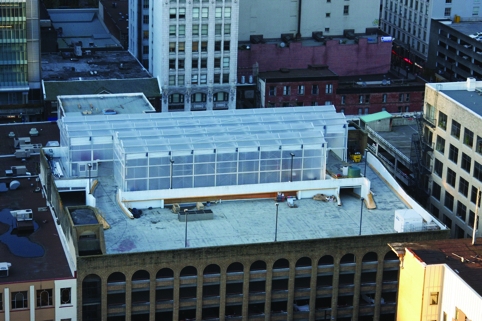
One of the keys to this is the conveyor, which, as well as ensuring that all of the plants are exposed to equal levels of light, heat and humidity, also enables the farm’s watering and harvesting operations to be concentrated in a particular area. ‘We can move the entire crop to two irrigation points on the system,’ said Ng. ‘Therefore we don’t have this huge infrastructure of plumbing where we need to bring water to all the crops. This also means that the crop can be harvested from one location, which allows us to be even denser in the way we squeeze the conveyor system in. We don’t need to allow for workers to be going up and down the aisles.’
Ng hopes that the Vancouver installation will be the first of many, and said that his team is already looking at developing a version of the system that features low-energy lighting in the conveyor tracks and could be used to grow crops in buildings with little or no natural light.
Meanwhile, back on this side of the Atlantic, Swedish company Plantagon is drawing up plans for a large-scale vertical farm that’s perhaps more in tune with Despommier’s grand vision.
The company, which — intriguingly — is 85 per cent owned by the Onondaga native American Indian tribe, is currently poised to begin construction of a vertical farm at a site in the city of Linkoping, 200km south-west of Stockholm.

At the heart of the system is a concept for a helical growing structure, designed to enable sunlight to penetrate to the core of the growing area.
Like Verticrop’s system, Plantagon’s technology also exploits the production-line benefits of continuously moving crops around the growing area, but rather than moving the entire conveyor, the company plans to use small machines running along the underside of the static rail to move the boxes one by one. Hans Hassle, chief executive officer at Plantagon, said that these devices — which will be cheap to run and easy to maintain — are currently being developed by Swedish engineering consultancy Saab Combitech.
However, it’s the way that the system will be integrated with the pre-existing local infrastructure that will be watched most keenly. And Hassle explained that by deriving much of its energy from existing sources of waste, the facility will be a demonstration of how vertical farms could be operated on an economically feasible basis. ‘It’s very difficult today to make a standalone vertical greenhouse economically viable but if you think in terms of industrial symbiosis then you can make it work from an economical perspective,’ he said. He added that Linkoping — a city that prides itself on an advanced approach to waste management — is the ideal site to trial this approach, and that the farm will be able to use waste heat from an adjacent power plant, as well as CO2 exhaust from a nearby biogas production facility.
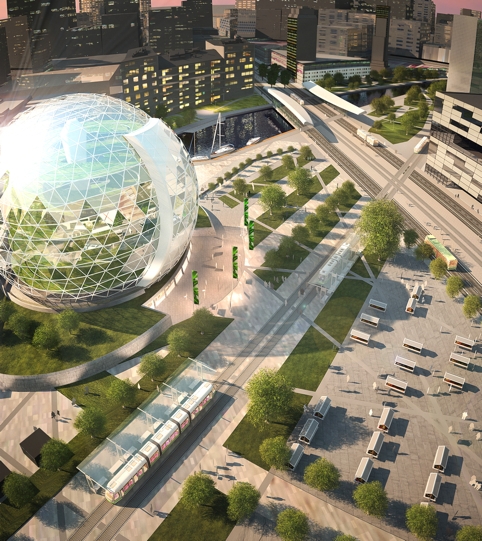
But amid all the excitement of cracking the technological challenges, Hassle is concerned that the vertical farming movement might have forgotten something: its customers.
He believes that the fledgling industry has a major PR battle to fight in order to persuade consumers to buy its produce and that, in tandem with the technical effort, it needs to quickly find a viable business model. ‘When you go to a grocery store you can choose 30 different sorts of lettuce. What we can produce in one building is just a few vegetables and we can’t produce everything at the same time. Where are you going to deliver your stuff to? Why would people want to use you? You have to find a totally new business concept on how to sell the produce.’
It’s a surprisingly bleak assessment from someone who is otherwise so enthusiastic about the prospects for the technology, but Hassle believes Plantagon has developed a compelling business model. And although he enigmatically declined to reveal details of what he terms the company’s key bit of intellectual property, the strategy should become clear when the Linkoping farm opens for business in 2014.

Despite the progress that’s already been made, there are clearly significant technological and economic challenges to overcome before vertical farming can begin to seriously compete with conventional approaches to agriculture.
But Despommier believes that there is no credible alternative.
In the conclusion to his book The Vertical Farm, he argues that traditional agriculture is not working. ‘Without irrigation and lots of additives farming could not go on indefinitely in the same place,’ he writes. ‘At the same time that our agricultural landscapes have been pushed to their limits… our population has just about risen to the point of no return — less land left to cultivate but still plenty of hungry mouths to feed. We have no… choice but to conclude that farming on soil is not a long-term sustainable solution to meeting our population’s energy needs — the vertical farm has the potential [to advance] agriculture to a place in history it has never before occupied: one of true sustainability.’
It’s not just about food
Perhaps the most compelling economic case for vertical farms currently lies beyond the world of food production.
Working with $40m (£24.8m) of funding from DARPA (the research arm of the US military) US researchers have built a vertical farm they believe could revolutionise the production of flu vaccines.
Based in San Antonio, Texas, the so-called Greenvax project, a collaboration between Texas A&M University and drug facility manufacturer G-Con, has built a 145,000ft2 facility that uses tobacco plants to grow vaccines for a host of diseases, including flu.
Flu vaccines are largely grown today in duck eggs, with each egg producing enough vaccine to immunise one person. According to the Greenvax researchers, a plant-based method could radically boost the amount of drugs that can be produced, and allow rapid response to newly emerging viruses not possible with current technology. The current facility has a projected scale capacity of 100 million doses per month.
Vertical farming systems are also being investigated by space scientists, who believe the technology could be used to grow food for long-distance manned space missions, and ultimately to build growing facilities on manned lunar outposts.
Indeed, working with $70,000 of NASA funding researchers at the University of Arizona’s Controlled Environment Agriculture Centre (CEAC) are developing a prototype lunar greenhouse that they claim could form the basis for one day growing crops on the moon or Mars.
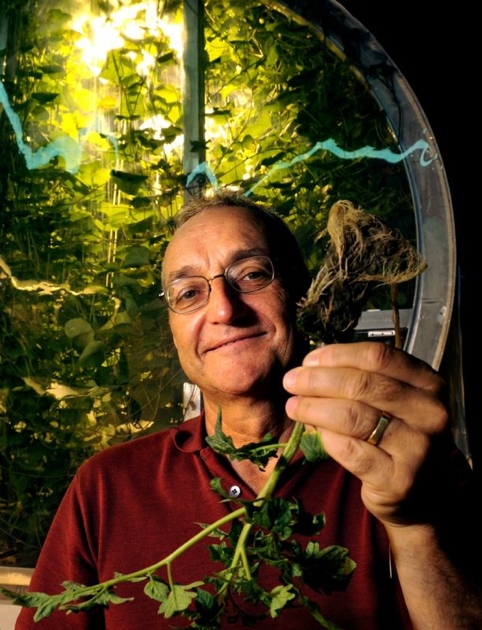
The team has developed an 8ft-long tubular structure that can be collapsed to a 4ft-wide disk for transport and then embedded in the surface of the moon.
The system is lined with water-cooled sodium vapour lamps and long envelopes that would be loaded with seeds, ready to sprout hydroponically. The breath of the astronauts would be used to provide CO2 while water for the plants would be extracted from astronaut urine.
The design is based on technologies developed for CEAC’s South Pole Growth Chamber — a system developed to provide fresh food for the South Pole Research Station, which is cut off from the outside world for up to eight months per year.











Comment: The UK is closer to deindustrialisation than reindustrialisation
"..have been years in the making" and are embedded in the actors - thus making it difficult for UK industry to move on and develop and apply...